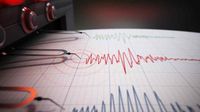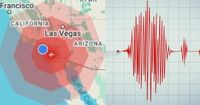A magnitude 5.2 earthquake shook California on Monday, April 14, 2025, with its epicenter located in Julian, approximately 2.5 miles south of the town, east of San Diego. The tremor was felt widely, reaching as far as Tijuana, Mexico, and even Los Angeles. According to the United States Geological Survey (USGS), the quake struck at 10:08 AM, prompting the activation of the ShakeAlert system, which is designed to warn residents of seismic activity.
Reports indicate that the earthquake was felt not only in the immediate vicinity but also in the border areas between Mexico and California, including Tijuana and Ensenada. Social media was abuzz with videos and comments from individuals who experienced the quake, showcasing the swaying of lamps and other objects in their surroundings.
In the aftermath of the quake, at least seven aftershocks were recorded in the San Diego area, raising concerns about potential damage. Governor Gavin Newsom stated that state authorities are collaborating with first responders to assess the situation. While the full extent of damages remains unclear, reports from local businesses, such as the Julian Cafe & Bakery, noted that several cups fell to the ground during the shaking.
Interestingly, this earthquake comes on the heels of a more powerful 6.7 magnitude quake that also rattled San Diego and was felt in Tijuana. Fortunately, authorities have ruled out any catastrophic damage in the seismic zones of California, although the frequency of these tremors serves as a reminder of the region's geological activity.
California is situated in what is known as the Ring of Fire, a region characterized by high seismic activity due to the constant friction between tectonic plates. This area generates approximately 90% of the world’s seismic activity and is home to 75% of the planet's active volcanoes. The Ring of Fire is often referred to as the "cradle of earthquakes," highlighting its significance in global tectonic dynamics.
In Mexico, the seismic landscape is similarly active. The country is located on the Cocos Plate and the North American Plate, which leads to the frequent release of energy in the form of earthquakes. As a result, Mexico has a highly developed seismic monitoring system, overseen by the National Seismological Service (SSN), which tracks seismic activity across the region.
Due to this high seismic risk, Mexico has established a robust earthquake alert system, known as the Mexican Seismic Alert System (SASMEX). This system is crucial for providing timely warnings to residents in affected areas, allowing them to take necessary precautions during seismic events.
In light of the recent quakes, the Center for Disaster Prevention (CENAPRED) has reiterated its recommendations for individuals during an earthquake. These guidelines emphasize the importance of remaining calm, seeking shelter under sturdy objects, and cutting off electricity, as well as closing water and gas valves to prevent further hazards. Additionally, for those outdoors, it is advised to stay clear of buildings, poles, and electrical wires, which can pose significant risks during seismic activity.
As the dust settles from the latest earthquake in California, residents are left to ponder the implications of living in such a seismically active region. The occurrence of tremors, while often unsettling, serves as a reminder of the Earth's dynamic nature and the importance of preparedness.
In summary, the magnitude 5.2 earthquake that struck California on April 14, 2025, underscores the ongoing seismic activity in the region, with effects felt across the border in Mexico. While authorities work to assess the damage and ensure safety, the event highlights the need for continued vigilance and preparedness in the face of natural disasters.






